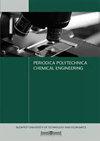饮用水处理中氯化和二氧化氯氧化副产物的形成
IF 1.8
4区 工程技术
Q3 ENGINEERING, CHEMICAL
引用次数: 0
摘要
人口增长、气候变化、自然和人为污染等造成的水资源日益短缺,可能会影响与水有关的传染病的发生。如今,获得清洁和安全的水是全世界日益关注的问题。因此,饮用水消毒是公共处理系统中至关重要的一步,因为它确保去除各种污染物,包括引起水传播疾病的病原微生物(原生动物、病毒、细菌和肠道寄生虫)。然而,在消毒过程中,由于化学消毒剂与天然有机物(NOM)、和/或原水中存在的人为污染物和/或溴化物/碘化物之间的反应,会形成不良的消毒副产物(DBPs)。尽管已有数百项关于DBPs生成的研究,但原水中物质的化学复杂性和非均质性使得DBPs的表征和形成机制相当困难和模糊。由于氯化法仍然是最经济、最常用的消毒方法,除氯化法外,二氧化氯的应用也越来越广泛,本文对氯和二氧化氯可能产生的DBPs进行了研究,重点介绍了它们对健康的不良影响。它概述了这些消毒剂与无机和有机化合物的反应。值得注意的是,为了更好地了解消毒剂在水处理中的性能,迫切需要进一步研究它们与水中发现的无机和有机化合物的作用机制。本文章由计算机程序翻译,如有差异,请以英文原文为准。
Byproduct Formation of Chlorination and Chlorine Dioxide Oxidation in Drinking Water Treatment
Increasing water scarcity caused by population growth, climate change, pollution from natural and anthropogenic sources, etc. is likely to impact the occurrence of water-associated infectious diseases. Nowadays, access to clean and safe water is a growing concern worldwide. Therefore, disinfection of drinking water is a vital step in public treatment systems as it ensures the removal of various contaminants, including pathogenic microorganisms (protozoa, viruses, bacteria, and intestinal parasites) that give rise to waterborne diseases. Nevertheless, undesirable disinfection byproducts (DBPs) are formed during disinfection as a result of reactions between chemical disinfectants and natural organic matter (NOM), and/or anthropogenic contaminants, and/or bromide/iodide that are present in the raw water. The chemical complexity and heterogeneity of matters in the raw water makes the characterization and the mechanism of DBPs formation quite difficult and ambiguous regardless of the previous hundreds of studies on DBPs generation. As chlorination is still the most economic and most often used disinfection method, and beside chlorination, the application of chlorine dioxide is becoming more widespread, this paper investigates the possible DBPs generated using chlorine and chlorine dioxide with highlighting their adverse health effects. It overviews the reactions of those disinfectants with inorganic and organic compounds. It is important to note that in order to better understand the performance of disinfectants in water treatment, further investigations on the mechanisms of them with inorganic and organic compounds found in water are critically needed.
求助全文
通过发布文献求助,成功后即可免费获取论文全文。
去求助
来源期刊

Periodica Polytechnica Chemical Engineering
ENGINEERING, CHEMICAL-
CiteScore
3.10
自引率
7.70%
发文量
44
审稿时长
>12 weeks
期刊介绍:
The main scope of the journal is to publish original research articles in the wide field of chemical engineering including environmental and bioengineering.
 求助内容:
求助内容: 应助结果提醒方式:
应助结果提醒方式:


